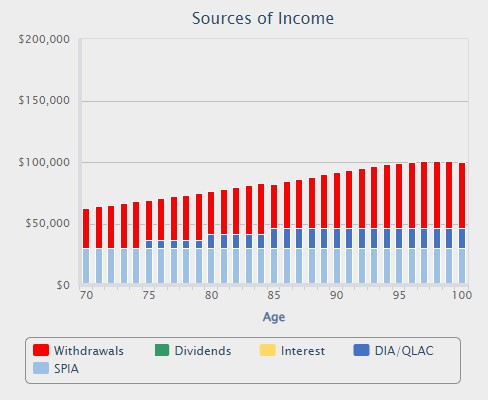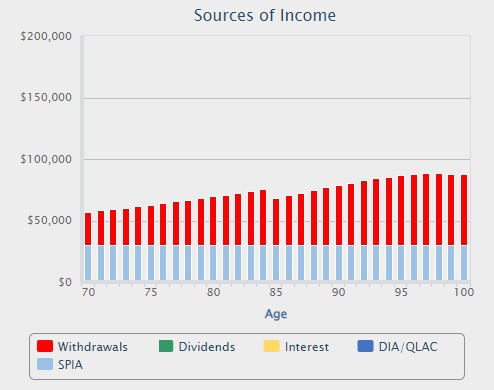How to Get More Retirement Income From Your 401(k)
An integrated approach of investments and annuities could provide you with more retirement income in addition to protection against inflation and late-in-life expenses.


One might yearn for the days of company pensions, but we live in the era of the 401(k) and similar plans, so we might as well take full advantage of them. That means socking away at least the maximum that your plan provides in pre-tax contributions and encouraging your bosses to offer matching payments and the investments that will best help grow your pot of retirement money.
In fact, at least 85% of all eligible employers offer a 401(k) and employees put an average of 6.5% of their salaries into them each year. According to a report by Fidelity, the average 401(k) balance reached $112,400 in the second quarter of this year.
All good news!

Sign up for Kiplinger’s Free E-Newsletters
Profit and prosper with the best of expert advice on investing, taxes, retirement, personal finance and more - straight to your e-mail.
Profit and prosper with the best of expert advice - straight to your e-mail.
Current options from your employer or AI
When you are ready to leave that job, however, things change. Very few, and particularly small businesses, employer-sponsored programs offer a retirement planning option. The most guidance you might get is something like, “You can stay invested in our investment portfolios and hope they produce regular income like your career did, or maybe you can invest your savings in an income annuity and enjoy the income safety annuities offer.”
Or, you might ask a chatbot like ChatGPT for advice. We asked, “How much income can I expect from the $1 million I have in my 401(k) plan when I take late retirement at age 70?” The answer was a generic recommendation to withdraw 4% a year for as long as you can.
None of those is a good enough alternative
If you stay wholly invested in the markets, you’ll need to withdraw your income from your savings, which is not the same as getting employer matches and reinvesting investment earnings, and taking advantage of dollar-cost averaging when the markets go down. (After retirement, when the markets dive, there’s no silver lining.) Remember that average investors on their own underperform the market by 1% to 2% per year.
Putting all your money into an income annuity is indeed safe, but may not get adequate inflation protection or have liquid funds for expenses like medical and caregiver costs. Even if your employer does suggest annuity choices, you should ask whether they are based on current rates in the market and offer a choice of competitive carriers.
And the 4% rule has been discredited by experts, particularly its performance in 2022 when both the bond and stock markets fell.
There is a better way, an integrated approach with both investments and annuities that provides more income and protection against inflation and late-in-life expenses, as well as a starting income percentage of more than 6% for some plans.
Use your qualified plan savings for income
I wrote in my recent article Do You Have Enough Money to Retire? That Is the Question that retirees should “focus on retirement income, but don’t lose sight of other considerations, like legacy and liquidity. Most important, wherever possible, test whether a particular product or strategy improves your income and other objectives.”
To illustrate, let’s examine two scenarios under IRA2Income planning for a 70-year-old female who has $1 million in her qualified savings accounts.
1. Maximize current income. In this scenario, our retiree will invest all of her savings in a balanced portfolio of stock and bond investments and two types of income annuities. Those annuities, in turn, will be split between (1) an immediate annuity with income starting at age 70 and (2) a deferred income annuity called a QLAC providing laddered income to protect against inflation.
You may remember news about the QLAC, or qualifying longevity annuity contract, from last year, when Congress enacted the SECURE 2.0 Act. A QLAC allows you to defer more taxes and buy more retirement income from your 401(k), rollover IRA or similar tax-qualified accounts. Despite the favorable legislation, not all employer-based planning integrates QLACs into their solutions.
Under this plan, pictured below, our retiree’s starting income is $62,700, or 6.27% of her savings. A far cry from 4%.

The value of her legacy at 95 will still be nearly $500,000 at age 95, despite having to meet RMD requirements. If she wants to leave a larger legacy for the grandkids, she can try to build up her personal savings. And her portfolio from qualified plan savings at age 95 is higher than it might have been because, with the guaranteed income from the annuities, she was able to take a little more risk on the withdrawals from her balanced portfolio allocation.
2. Build a cushion for late-in-retirement expenses. In this scenario, our investor puts $100,000 of her $1 million of savings in a QLAC that will provide payments of $25,000 per year at age 85. She is looking ahead to health care insurance premiums and costs that may kick in with home aides, procedures or hospitalization.
Her starting income under this plan, from the $900,000 that remains in savings at 70, will be $57,063.

Even after 25 years of taking payments from the investments she built up as she saved for retirement, her legacy will amount to $509,000. Of course, she’ll also have the $25,000 per year from the QLAC.
These are just two of the many options that you can design for yourself. There’s even one more on the Go2Income drawing board, particularly for younger new retires who like the safety of these plans but don’t want to pay taxes before RMDs are required. (Contact me if you’d like to discuss this feature.)
Part of your total plan
For all the good that your 401(k), IRA and similar products can do for your retirement, they aren’t the only consideration. You will likely also have personal savings, Social Security and possibly a pension that will all add to your income potential. You can look at each separately (with IRA2Income and Savings2Income, for example) or integrate all income sources into an overall Go2Income plan based on your specific circumstances and needs, including how to find the best annuity provider among the highest-rated insurance companies. Those are all benefits you won’t get from your former employer or artificial intelligence.
To try out a plan, visit Go2Income, answer a few simple questions and get started on a plan to create maximum income from your savings.
related content
Get Kiplinger Today newsletter — free
Profit and prosper with the best of Kiplinger's advice on investing, taxes, retirement, personal finance and much more. Delivered daily. Enter your email in the box and click Sign Me Up.

Jerry Golden is the founder and CEO of Golden Retirement Advisors Inc. He specializes in helping consumers create retirement plans that provide income that cannot be outlived. Find out more at Go2income.com, where consumers can explore all types of income annuity options, anonymously and at no cost.
-
 Stock Market Today: Stocks Surge to Close a Volatile Week
Stock Market Today: Stocks Surge to Close a Volatile WeekIt was another day with a week's worth of both news and price action, but it ended on a strongly positive note.
By David Dittman Published
-
 Which Stocks Stayed Green as the Market Plummeted?
Which Stocks Stayed Green as the Market Plummeted?Only a handful of S&P 500 stocks managed to generate gains during the market's historic four-day plunge.
By Dan Burrows Published
-
 Could You Retire at 59½? Five Considerations
Could You Retire at 59½? Five ConsiderationsWhile some people think they should wait until they're 65 or older to retire, retiring at 59½ could be one of the best decisions for your quality of life.
By Joe F. Schmitz Jr., CFP®, ChFC® Published
-
 Home Insurance: How to Cut Costs Without Losing Coverage
Home Insurance: How to Cut Costs Without Losing CoverageNatural disasters are causing home insurance premiums to soar, but don't risk dropping your coverage completely when there are ways to keep costs down.
By Jared Elson, Investment Adviser Published
-
 Markets Roller Coaster: Resist the Urge to Make Big Changes
Markets Roller Coaster: Resist the Urge to Make Big ChangesYou could do more harm than good if you react emotionally to volatility. Instead, consider tax-loss harvesting, Roth conversions and how to plan for next time.
By Frank J. Legan Published
-
 Why Homeowners Insurance Has Gotten So Very Expensive
Why Homeowners Insurance Has Gotten So Very ExpensiveThe home insurance industry is seeing more frequent and bigger claims because of weather, wildfires and other natural disasters.
By Karl Susman, CPCU, LUTCF, CIC, CSFP, CFS, CPIA, AAI-M, PLCS Published
-
 Going Through Probate? How to Find the Right Attorney
Going Through Probate? How to Find the Right AttorneyJust having the skills and experience to do the job isn't enough. The probate attorney you hire needs to have the right temperament for your particular case.
By John R. Silva, Esq. Published
-
 Widow's Penalty: Three Ways to Protect Your Finances
Widow's Penalty: Three Ways to Protect Your FinancesHigher Medicare premiums, smaller Social Security payments, bigger tax bills … Financial changes can hit hard when a spouse dies. How to counter the blow.
By Ashley Terrell, IAR Published
-
 Four Ways Your Phone Can Help You Weather Market Volatility
Four Ways Your Phone Can Help You Weather Market VolatilitySmartphone apps can help investors make healthy decisions and maintain a disciplined investment approach — even when emotions try to steer them off course.
By Marco De Freitas Published
-
 Stick to the Plan: Don't Panic During Economic Uncertainty
Stick to the Plan: Don't Panic During Economic UncertaintyTake a breath and step back. Focus on a solid fiscal foundation to stabilize your investments during stock market volatility.
By Eric Lahaie, CFS®, RICP® Published